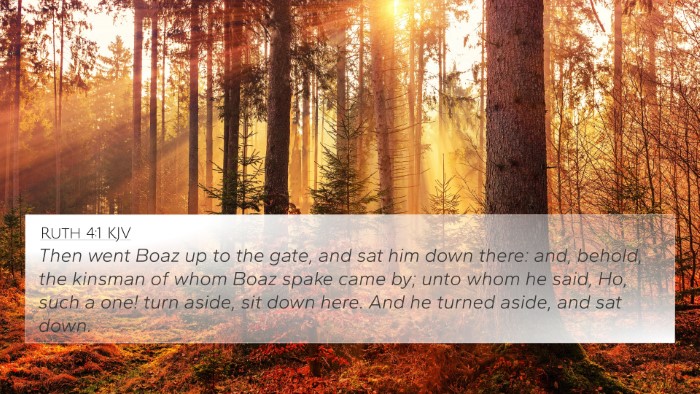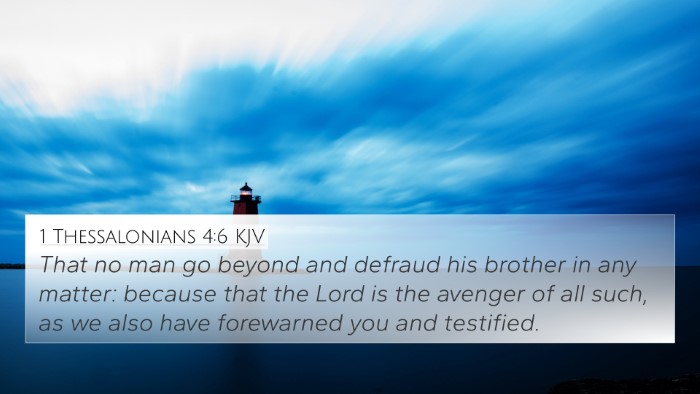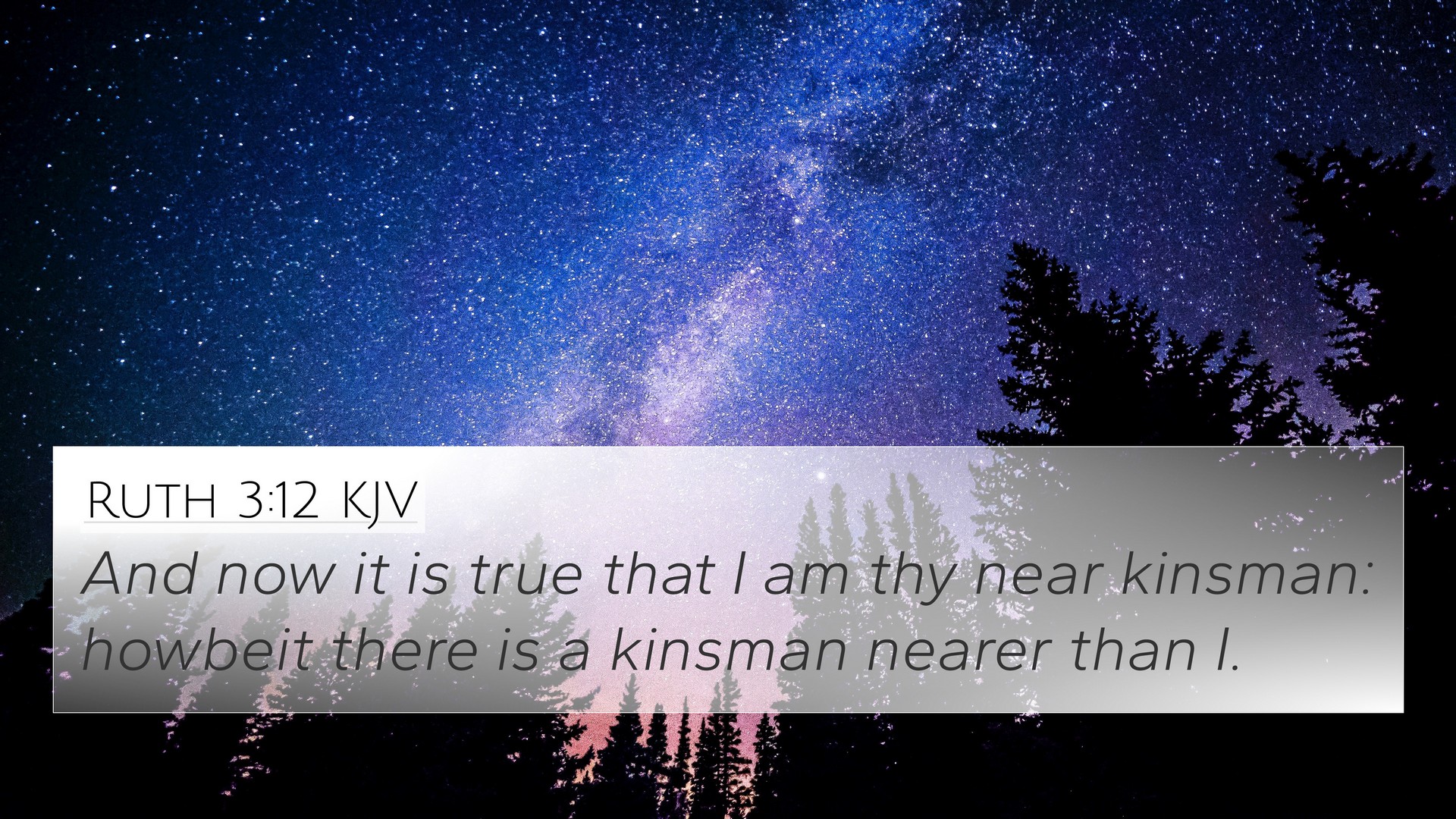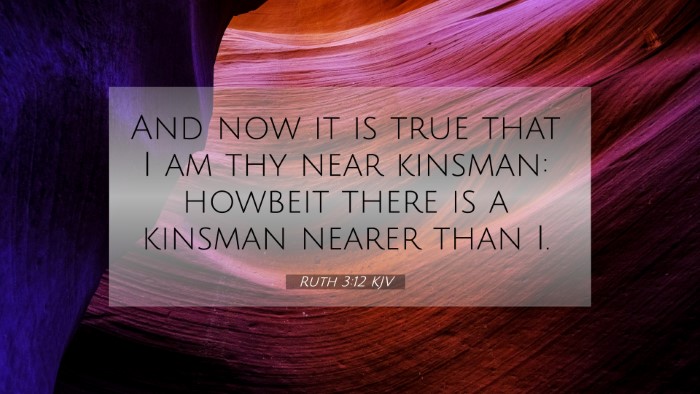Old Testament
Genesis Exodus Leviticus Numbers Deuteronomy Joshua Judges Ruth 1 Samuel 2 Samuel 1 Kings 2 Kings 1 Chronicles 2 Chronicles Ezra Nehemiah Esther Job Psalms Proverbs Ecclesiastes Song of Solomon Isaiah Jeremiah Lamentations Ezekiel Daniel Hosea Joel Amos Obadiah Jonah Micah Nahum Habakkuk Zephaniah Haggai Zechariah MalachiRuth 3:12 Similar Verses
Ruth 3:12 Cross References
And now it is true that I am thy near kinsman: howbeit there is a kinsman nearer than I.
Uncover the Rich Themes and Topics of This Bible Verse
Listed below are the Bible themes associated with Ruth 3:12. We invite you to explore each theme to gain deeper insights into the Scriptures.
Ruth 3:12 Cross Reference Verses
This section features a detailed cross-reference designed to enrich your understanding of the Scriptures. Below, you will find carefully selected verses that echo the themes and teachings related to Ruth 3:12 KJV. Click on any image to explore detailed analyses of related Bible verses and uncover deeper theological insights.

Ruth 4:1 (KJV) »
Then went Boaz up to the gate, and sat him down there: and, behold, the kinsman of whom Boaz spake came by; unto whom he said, Ho, such a one! turn aside, sit down here. And he turned aside, and sat down.

1 Thessalonians 4:6 (KJV) »
That no man go beyond and defraud his brother in any matter: because that the Lord is the avenger of all such, as we also have forewarned you and testified.

Matthew 7:12 (KJV) »
Therefore all things whatsoever ye would that men should do to you, do ye even so to them: for this is the law and the prophets.
Ruth 3:12 Verse Analysis and Similar Verses
Understanding Ruth 3:12
The verse from Ruth 3:12 states:
"And now it is true that I am a redeemer. Yet there is a redeemer nearer than I."
This verse holds significant meaning within the context of the book of Ruth, emphasizing themes of redemption, family loyalty, and the importance of social structures in Israelite culture. The following analysis incorporates insights from well-respected public domain commentaries such as Matthew Henry, Albert Barnes, and Adam Clarke.
Contextual Background
The story of Ruth unfolds during the time of the judges in Israel, a period characterized by social and moral decline. Ruth, a Moabite woman, demonstrates unwavering loyalty to her Israelite mother-in-law, Naomi. Their journey back to Bethlehem highlights the significance of kinship and God's providence in their lives.
Analysis of the Verse
In Ruth 3:12, Boaz acknowledges his role as a redeemer but also indicates that there is another, closer relative who has the first right to redeem. This reflects the social customs established in Levitical law regarding inheritance and familial duty, particularly concerning the kinsman-redeemer role.
Insights from Commentaries
-
Matthew Henry:
Henry emphasizes the moral and social responsibilities inherent in the role of a redeemer. He notes that Boaz's humility and respect for the established customs demonstrate God's orderly provision through human relationships. The phrase "yet there is a redeemer nearer than I" reveals Boaz's integrity and willingness to adhere to God's law.
-
Albert Barnes:
Barnes highlights the significance of the word "redeemer," noting its implications for both social and spiritual redemption. The presence of a nearer redeemer introduces a tension that must be resolved within the narrative, underscoring the broader theme of God's ultimate providence and the unfolding plan of salvation.
-
Adam Clarke:
Clarke offers insight into the legal implications of Boaz's statement, noting that the nearest redeemer had the legal claim to restore Naomi's family line. This acknowledgment by Boaz demonstrates his commitment to righteousness and the law, reinforcing the value of divine order in community and family life.
Thematic Connections and Cross-References
Ruth 3:12 invites us to explore various cross-references throughout the Bible that enrich our understanding of redemption and divine providence. Below are some key verses that resonate with the themes in Ruth 3:12:
- Leviticus 25:25: Discusses the duty of the kinsman-redeemer in restoring property to family members in need.
- Matthew 1:5: Mentions Ruth in the genealogy of Jesus, highlighting her important role in God's salvific history.
- Hebrews 7:23-25: Refers to Christ as our ultimate redeemer, who intercedes for us, showing a greater fulfillment of the redeemer's role.
- Galatians 4:4-5: Illustrates the redemptive work of Christ in adopting us into God's family.
- Job 19:25: Job's proclamation about his Redeemer ties into the theme of hope and restoration.
- Isaiah 59:20: Speaks of the Redeemer coming to Zion, linking redemption to a broader covenantal promise.
- 1 Peter 1:18-19: Emphasizes that we are redeemed not with perishable things but with the precious blood of Christ, echoing the theme found in Ruth.
Applications and Reflections
The implications of Ruth 3:12 extend beyond mere historical narrative. The themes of kinship, integrity, and God's providential care encourage believers to reflect on their own lives and relationships. Questions to consider:
- How do we fulfill our responsibilities to those in our communities?
- In what ways can we acknowledge and honor the roles of others within our spiritual family?
- How does understanding Christ as our redeemer shape our view of personal sacrifices and relationships?
Conclusion
Ruth 3:12 serves as a vital connecting point within the narrative of Scripture, illustrating God's unwavering commitment to redeem His people through established social structures and divine providence. By exploring the rich tapestry of cross-references, believers can gain a deeper understanding of their faith and the overarching narrative of God's redemptive work.
Further Study and Resources
For those interested in delving deeper into the concept of biblical redemption and the kinsman-redeemer role, consider utilizing:
- Tools for Bible cross-referencing, including a Bible concordance for finding related verses.
- Bible cross-reference guides, which help connect themes across both Testaments.
- Cross-reference Bible study methods that enhance understanding through comparative analysis.
- Bible reference resources for sermon preparation or personal study.
Through inter-Biblical dialogue, connections between the Old and New Testaments, and thematic Bible verse connections, one can appreciate the depth and richness of God’s Word, ultimately finding personal application and understanding in verses like Ruth 3:12.


